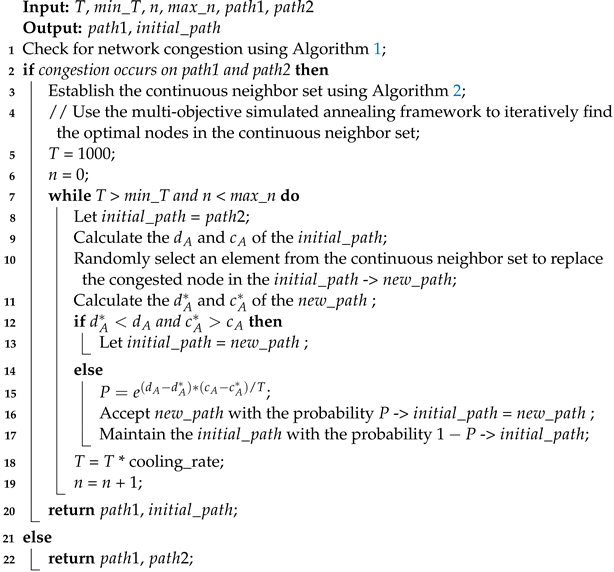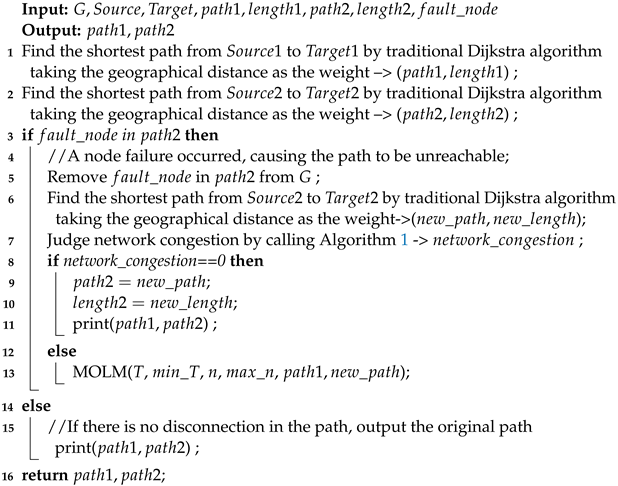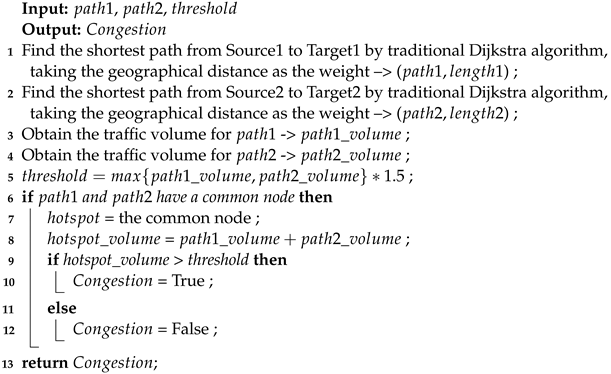MOLM: Alleviating Congestion through Multi-Objective Simulated Annealing-Based Load Balancing Routing in LEO Satellite Networks
[ad_1]
1. Introduction
Satellite internet, as a communication network with extensive coverage and high flexibility, is gradually becoming a crucial means of global connectivity. However, due to its unique communication characteristics and resource constraints, satellite internet often faces challenges of load imbalance when confronted with large-scale user demands. Optimizing load balance is essential for improving the performance of satellite internet and reducing communication latency. While load balancing issues have been extensively researched and applied in traditional ground communication networks, the peculiarities of satellite internet make this problem more complex and challenging.
The core of the load balancing problem lies in the proper allocation of communication loads within the satellite internet system, ensuring the maximization of resource utilization for each satellite node to enhance overall communication efficiency. However, factors such as an uneven geographical distribution of satellite nodes, variability in satellite conditions, and resource limitations pose constraints on the applicability of traditional load balancing strategies in satellite internet.
To address the load balancing issue in satellite internet, many strategies use the latency of new paths as an evaluation metric without considering path stability. However, path stability is also an important factor, as the dynamics of satellite networks and satellite movements can lead to path switching, resulting in switching and routing maintenance costs. Choosing a path with high stability can reduce costs. This paper proposes a low-maintenance, cost–load balancing routing method based on the multi-objective simulated annealing algorithm, named MOLM. Simulated annealing, as a heuristic optimization algorithm, possesses global search capabilities and adaptability to multi-objective optimization problems. When network congestion occurs, a continuous neighbor set is established, and the multi-objective simulated annealing algorithm is used to select neighboring satellites that satisfy both strong path stability and low latency to replace congested nodes, thereby improving the overall performance of the satellite internet system.
The main contributions of the paper are embodied in the following aspects. (1) Based on the predictability of satellite networks, the concept of a continuous neighbor set is proposed, which includes nodes that can maintain continuous connections with the predecessor and successor of congested nodes. (2) The MOLM algorithm is used, which employs the multi-objective simulated annealing (MOSA) framework to iteratively derive an optimal element from the continuous neighbor set to replace congested nodes within a specific path, generating the final solution aimed at alleviating network congestion. (3) A comprehensive comparative experiment is conducted to demonstrate the performance of the MOLM algorithm, including comparative experiments under different networking methods and varying satellite constellation densities. Finally, the reliability of FRR-BP is measured using the time taken to reconstruct backup paths.
4. Algorithm Design
4.1. Overview of the MOLM Algorithm
4.2. Judgment of Network Congestion
| Algorithm 1: Judgment of Network Congestion |
4.3. Establishment of the Continuous Neighbor Set
If congestion occurs, we use the MOLM algorithm to resolve the congestion. Before that, we need to establish a continuous neighbor set, which includes nodes that can maintain continuous connections with both the predecessors and successors of the congested node. The process of establishing the continuous neighbor set can be described using Algorithm 2.
| Algorithm 2: Establishment of the Continuous Neighbor Set |
 |
Therefore, the nodes adjacent to nodes 5 and 7 at the current time t can be represented as = {1,0,1,0,0,1,1} and = {1,0,0,1,1,1,0}, and the nodes adjacent to nodes 5 and 7 at time can be represented as ={1,0,1,1,0,1,0} and = {1,1,0,1,0,1,0}. Let P = () ∩ () = {1,0,0,0,0,1,0}, where P represents the continuous neighbor set. The nodes in the continuous neighbor set are node 1 and node 6.
4.4. The Design of MOLM
| Algorithm 3: MOLM |
 |
4.5. Fast Rerouting Mechanism
| Algorithm 4: Fast Rerouting Method Based on Backup Paths (FRR-BP) |
 |
5. Simulation Experiment Evaluation
5.1. Simulation Environment
5.2. Benchmarking Algorithms and Complexity Analysis
Our proposed MOLM algorithm aims to address network congestion issues, and we analyze its complexity in this part. The core idea of the MOLM algorithm is to establish a continuous neighbor set during network congestion and then utilize a multi-objective simulated annealing framework to select the best node from this set to replace congested nodes, achieving the goals of avoiding congestion while maintaining path stability and low latency.
is based on a greedy algorithm for node replacement. It employs a greedy strategy to select nodes from the continuous neighbor set, optimizing path stability and latency of the entire path. The strategy of generates the shortest path for congested traffic in the network, aiming to minimize latency. The difference between the two is that selects one node from a limited number of nodes, namely those in the continuous neighbor set, to minimize latency. Meanwhile, the shortest path algorithm searches for a route from to , resulting in the globally minimal latency path.
Firstly, we discuss the complexity of the MOLM algorithm. For the filtering process of the continuous neighbor set, we note that its time complexity is approximately O(n), where n represents the cardinality of the continuous neighbor set. Similarly, for the selection of the best node, we employ the Optimum method based on a greedy algorithm, with a time complexity that is also approximately O(n). This is because, under the greedy strategy, selecting nodes from the continuous neighbor set is a relatively efficient operation.
Furthermore, the complexity of the shortest path algorithm is also discussed. We use the Dijkstra algorithm to find the shortest path. Due to the +Grid networking method employed, with each satellite maintaining four connections, the topology graph is relatively sparse. Therefore, its time complexity is approximately O(nm), where m represents the number of edges in the network.
In summary, the MOLM algorithm exhibits low time complexity in addressing network congestion issues, making it capable of efficient operation in practical applications and effectively enhancing network performance.
5.3. Simulation Result
In terms of path stability, when using a shortest-path-first rerouting mechanism to address network congestion, the average path duration is approximately 125 s. By employing the MOLM algorithm in conjunction with multi-objective simulated annealing to address congestion, the average path duration can exceed 225 s. This represents an improvement of around 80% compared to the strategy.
This is because the strategy prioritizes the selection of the shortest path, sacrificing path stability in pursuit of minimizing latency. In contrast, the nodes selected by the MOLM algorithm in the continuous neighbor set maintain sustained connections with the predecessor and successor nodes of congested nodes, contributing to robust path stability. After undergoing iterations of multi-objective simulated annealing, the nodes selected by MOLM are very close to the global optimum, resulting in a minimal latency cost.
Whether considering path latency or path stability, the results obtained with the MOLM algorithm approach those achieved by the strategy. This highlights the characteristic of multi-objective simulated annealing of gradually converging towards the global optimum through iterations.
From the graph, it can be observed that the convergence characteristic curve is not strictly monotonic, indicating that the simulated annealing algorithm possesses the ability to escape from local optima and converge towards global optimum solutions.
5.4. The Impact of Networking Methods on Algorithm Performance
Network topology methods refer to the schemes by which network nodes form a topology. Common satellite network topology methods include Sparse, +Grid, and Ideal. Sparse indicates a sparse topology where each satellite can maintain only two connections. Specifically, a satellite connects to the satellites immediately before and after it in the same orbit. +Grid represents a grid topology where each satellite can maintain four connections. In addition to the two connections mentioned in Sparse, a satellite can also connect to the nearest satellites in the adjacent left and right orbits. In an ideal topology, each satellite can connect to any other satellite within its visible range, and there is no limit on the number of connections.
Due to the sparsity of the topology in the Sparse case, which may hinder the establishment of a continuous neighbor set, the MOLM algorithm is tested in both +Grid and Ideal scenarios. The results are averaged over 1000 steps and compared with and .
Regarding path latency, in the +Grid scenario, MOLM’s path latency increases by about 7.66 ms, approximately 10.81%, compared to the . In the Ideal scenario, MOLM’s path latency increases by about 7.22 ms, approximately 20.36%, compared to the . In the Ideal scenario, the path latency for all three strategies is significantly lower than the path latency in the +Grid scenario. This is because the strategy prioritizes the shortest path, and in the Ideal scenario, where the topology has high connectivity and numerous selectable neighbors, it is easier to find paths with lower latency. However, the trade-off is more frequent path switches and worse path stability. Therefore, in the Ideal scenario, the MOLM algorithm exhibits a particularly noticeable improvement in path stability.
Through the MOLM algorithm, nodes that can replace congested nodes and maintain longer connections with predecessors and successors are added to the continuous neighbor set. The multi-objective simulated annealing algorithm selects the optimal node from this set to replace the congested node, reducing path switches and significantly improving path stability. As the multi-objective simulated annealing algorithm considers both path latency and path stability, it enhances path stability while maintaining a relatively low latency cost.
5.5. The Impact of Constellation Density on Algorithm Performance
From the perspective of path stability, the stability obtained by the algorithm decreases as the constellation density increases. In contrast, the path stability obtained by the MOLM algorithm does not exhibit a monotonic decrease but rather shows two significant peaks at constellation densities of and . In terms of latency, all three strategies adhere to the rule that “higher constellation density leads to lower path latency”. Therefore, this implies that in certain constellations with specific simulation characteristics (orbit height of 1200 km, inclination of 60 degrees, and constellation density of or ), when network congestion occurs, the new paths obtained using the MOLM algorithm can achieve a good trade-off between stability and latency.
5.6. Evaluation of FRR-BP
We integrate the MOLM algorithm with a Fast Reroute mechanism based on backup paths. After using multi-objective simulated annealing to select continuous neighbors for replacing congested nodes, if any node along the newly selected path experiences a failure, we promptly initiate the Fast Reroute based on backup paths. When establishing backup paths, two considerations are essential: first, avoiding the failed node, and second, steering clear of congested nodes to prevent potential congestion on the newly created backup path. Additionally, if the newly generated backup path still encounters network congestion with other existing traffic paths, we further employ the MOLM algorithm to alleviate network congestion.
In the +Grid scenario, even with a constellation density of (2500 satellites in total), the reconstruction time remains within 1000 ms, which aligns with expectations. However, in the Ideal scenario, where there are no restrictions on the number of connections between satellites, the increase in connection density with rising constellation density leads to a rapid increase in backup path reconstruction time. This is a normal occurrence. Nevertheless, at lower constellation densities, the backup path reconstruction time remains relatively low, within 1000 ms.
[ad_2]


